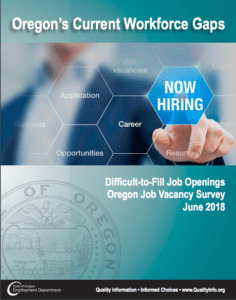A recent report by the Oregon Employment Department’s Workforce and Economic Research Division identifies Oregon’s current workforce gaps and future workforce needs. Manufacturers won’t be surprised by these results. Lack of applicants is the leading cause of unfilled positions, followed closely by a lack of skilled / qualified candidates and unfavorable working conditions. In a slight variation from the report, our clients are finding that it takes longer to source candidates who are a fit for their job and company culture.
So what you can you do about it? We have been helping companies small and large combat these exact issues for several years. A few key observations that may help your business:
- When you find qualified applicants, it’s important to move quickly through the hiring process – interviews should be scheduled promptly and hiring decisions made speedily
- Keep your potential candidates engaged during the hiring process – keep in touch, even if it is a quick email telling them where they are at in the process and next steps
- Creating career pathways for your existing employees will keep them engaged and will keep turnover low
- Showing career pathways to potential candidates will entice them to work for you – they will see a clear path forward and opportunities to grow
Highlights from the Report
Oregon businesses reported 60,700 job vacancies at any given time in 2017. Of these vacancies, 38,700 job openings (64%) were reported as difficult to fill. This is the largest number of vacancies and difficult-to-fill vacancies recorded since the current form of Oregon’s Job Vacancy Survey began in 2013. Here are a few highlights from the full report:
-
A lack of applicants was the most common reason given for difficulty filling vacancies. Almost one-third (30%) of difficult-to-fill job vacancies had an insufficient number of applicants or no applicants at all. That reflects a tight labor market with continued job growth and the unemployment rate at a historic low.
- The majority of vacancies were difficult to fill in all areas of Oregon. The highest shares of difficult-to-fill job openings occurred in Southwestern Oregon (74%) and in Clackamas and Northwest Oregon (73% in each).
- The occupations with the largest number of difficult-to-fill vacancies included heavy and tractor trailer truck drivers, carpenters, personal care aides, construction laborers, farmworkers and laborers, and restaurant cooks. These top the list of 354 occupations with difficult-to-fill vacancies.
- Difficult-to-fill vacancies offered higher average wages than non-difficult vacancies. The average offered wage was $18.28 per hour for difficult-to-fill vacancies and $16.62 for vacancies filled without difficulty.
- Difficult-to-fill vacancies were more likely to require previous work experience. Sixty-seven percent of difficult-to-fill vacancies required previous work experience, while just 40% of vacancies filled without difficulty required previous experience.
Relatively strong demand for workers should continue, based on economic trends and forecasts designed to predict Oregon’s Future Workforce Needs.
Oregon’s total employment is projected to grow by 12% between 2017 and 2027. Statewide we expect to see a total of 246,000 new jobs over the decade, and an annual average of 263,000 total job openings.
Here are a few additional highlights from the industry and occupational projections:
- All private sectors will add jobs. Federal government is the only broad sector expected to decline (-300 jobs) over the decade.
-
All areas of the state show projected growth. The two regions projected to grow faster than Oregon statewide are Central Oregon (15%) and the Portland area (13%).
- Private health care and social assistance will account for one out of every five new jobs in Oregon by 2027. Eleven of the top 20 fastest-growing occupations (with at least 1,000 jobs) in Oregon are either health care practitioners or health care support workers.
-
For every one new job created by new or expanding businesses, businesses will have another nine job openings that require newly trained workers to replace those who leave the labor force or make a major occupational change.
- At the typical entry-level education, one-third of all job openings will require education beyond high school. To meet more competitive education requirements, nearly half of all job openings include at least some training beyond high school.
For questions regarding the content of this publication, contact Nick Beleiciks – Nick.J.Beleiciks@oregon.gov (503) 947-1267
Detailed industry and occupational projections are available on QualityInfo.org. Excel files for all areas are on the Publications page, and a new Projections page features interactive graphs. Occupational employment projections have also been integrated into online interactive data tools such as the Occupation Profiles page.




